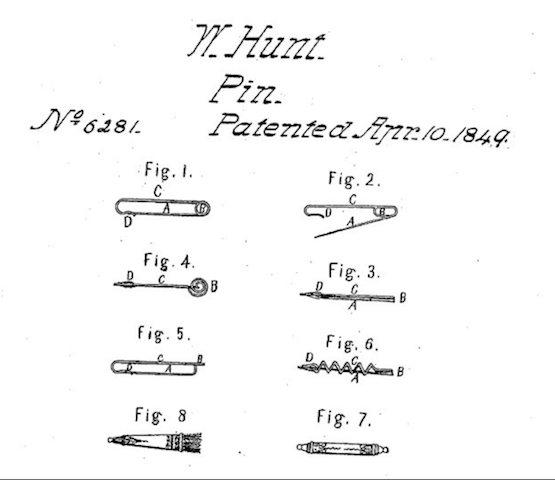
Did you know that before the Winchester repeating rifle was invented, Walter Hunt patented the “combined piston breech and firing cock repeating gun”?
Not only that, according to the Smithsonian, he also invented the fountain pen, the sewing machine, and that little thing most of us call the safety pin. While they certainly don’t pack the power of a repeating gun, there are a number of survival uses for safety pins if you include them in your EDC kit.
When it comes to survival , the ideal thing is to have a good EDC kit and some first aid supplies or a bug out bag. But what happens if you get caught out away from home without your bug out bag and first aid kit?
We’ve listed suggested uses for keeping safety pins in your EDC kit below. Please keep in mind using safety pins for some of these things are recommended as a last resort, meaning when you have no other option. We are NOT recommending that you rely primarily on safety pins for tasks critical to survival.
Also keep in mind this article is NOT medical advice, and anything you do is at your own risk, and neither the author nor www.SurvivalSullivan.comcan shall be held liable for any injuries or negative effects as a result of putting the advice of this article into practice.
#1. Remove Foreign Objects Under the Skin
Just about everyone has probably experienced getting a splinter or some other small sharp object stuck under their skin. Use an open safety pin similar to tweezers to remove splinters, thorns, insect stingers, ticks or even the dreaded botfly. With insects, make doubly sure you know what the risks are and seek medical advice first if available.
#2. Flush Out a Wound
Once you’ve removed a splinter or other foreign object, it’s probably a good idea to flush out the wound to ensure it’s as clean as possible. You can use a safety pin to poke a hole in a water bottle or plastic bag filled with water so that you can have a precise stream and conserve water for later.
#3. Stitch a Wound
It’s not the recommended way to stitch up that cut on your arm but in a pinch, if you don’t have a needle, you can make a safety pin work. Be extremely gentle and take care not to break it off as you pull.
#4. Secure Bait
If you find yourself in a survival situation where you need to use a trap to catch food, the last thing you want to do is risk the prey snagging the bait without setting off the trigger. You can use a safety pin to secure your bait to the trigger so there’s less chance of your prey getting away with a snack and leaving you with an empty belly.
#5. Replace a Button
Although probably not a true survival situation, you can use a safety pin to replace a missing button on your shirt or pants.
#6. Sewing Awl
In a pinch, you can use larger safety pins as an awl for sewing heavier material such as leather, burlap, or canvas.
Straighten out the pin and use the sharp end to pierce the material, twisting it around a bit to make the hole large enough for your cordage. Push the cordage through the holes using the tip of the pin or your finger depending on which is easier.
#7. Hang Clothes to Dry
When we camp, there are times that it rains or that we need to hang wet clothes or other items overnight. If you drop your wallet in the stream or your jacket falls from your backpack into the mud. You can use clothespins to secure lightweight items to dry overnight from the inside of your tent using some cordage or even a bungee cord stretched between the poles.
#8. Fishing Hook
It’s not ideal but you can use a safety pin as a makeshift fishing hook by tying it to your fishing line and then opening the pin and bending it into the shape of a hook. Add your bait and drop the line in the water. It will only work with smaller fish obviously but it’s better than nothing in a survival situation.
#9. Secure DIY Bandage
If you are injured unexpectedly and need to bandage the wound but don’t have traditional bandages, a safety pin might be a lifesaver. Tear or cut a strip of clothing or other available clean material, wrap it around the wound and secure temporarily with safety pins.
#10. Escape Handcuffs or Locked Room
When SHTF, it’s entirely possible for you to be taken captive by someone who wants your supplies, property, or worse. In the absence of a good lock picking kit, you can use a safety pin to help you pick a lock and escape.
#11. Make a DIY Sling or Splint
If someone falls during a bug out or other type of survival situation and you need to immobilize their arm or shoulder, you can use a safety pin to attach their sleeve to another part of their clothing or put a stick on each side of a damaged finger and wrap with cloth and secure with a safety pin.
#12. Close or Attach a Makeshift Shelter
Again, in a survival situation, I really hope you’ll have better shelter building materials on hand but in a pinch, you can use safety pins to attach clothing or any other type of available cloth together to create a makeshift albeit very temporary shelter.
#13. Reinforce Zippers
Replace a broken zipper pull on your bug out bag with a closed safety pin or use a safety pin to fasten two zippers together to keep them from working open during your bug out.
#14. Repair a Rip or Tear
Depending on the situation you are in, the landscape, and how quickly you need to move, you may not have time to properly fix a tear in your bug out bag, a loose pant leg hem, or that rip in the sleeve of your jacket from catching it on a branch. Safety pins come in really handy for temporarily keeping things together.
#15. Fix Unthreaded Drawstring
There’s nothing more important in a bad weather survival situation than staying warm. If you find yourself in extreme weather with a jacket hood or sweatshirt with no drawstring, you’ll be scrambling to keep it up and stay warm. Use a safety pin and any piece of cordage to replace the drawstring so you can keep your head covered and your hands free.
#16. Toothpick
It may not save your life, but it could save you some frustration and agony if you get a seed or something else stuck between your teeth in a survival situation. Take care not to puncture your gum and cause an additional issue.
#17. DIY Lance
If you don’t have a needle and you need to lance a boil, smashed fingernail, etc. you can heat a safety pin to sterilize it and use the tip as a lance.
Have we convinced you yet to include safety pins in your EDC kit? You can carry them just about anywhere very discreetly. Pin them inside the hem of your pant leg or the inside of a hat that is part of your EDC. Slide a couple in your wallet or pin into your shoelaces.
Do you have other survival uses for safety pins that we neglected in our list above? Ever use a safety pin for a really unusual repair before? Let us know in the comments below. We always love to hear good ideas from other preppers and homesteaders.
Other self-sufficiency and preparedness solutions recommended for you:
The Lost Ways (The vital self-sufficiency lessons our great grand-fathers left us)
Survival MD (Knowledge to survive any medical crisis situation)
Backyard Liberty (Liberal’s hidden agenda: more than just your guns…)
Alive After the Fall (Build yourself the only unlimited water source you’ll ever need)
The Lost ways II (4 Important Forgotten Skills used by our Ancestors that can help you in any crisis)
The Patriot Privacy Kit (Secure your privacy in just 10 simple steps)




















